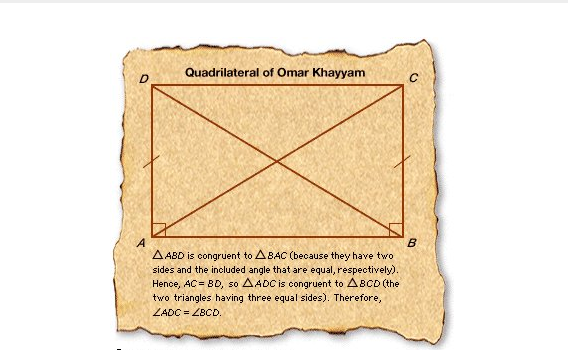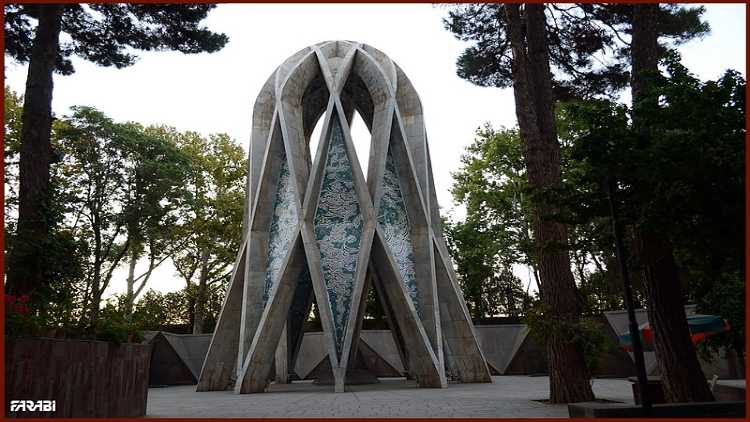
Manjit Thakur / New Delhi
The mathematician and poet Omar Khayyam was born in Neyshbar (Iran), a few years before the death of al-Biruni.
Later he lived in Samarkand and Isfahan where his work of tenth-century mathematics was carried forward. Not only did he find a simple way to get the square root of high-value numerals, but he also solved the cubic equations in his algebra.
Khayyam, who had a special interest in mathematics, started geometric algebra and introduced geometric solutions to equations related to algebra. He gave the existing quadratic equation in algebra. Apart from this, he also used Pascal's Triangle and Bionomics Coefficient’s Triangle Array for the first time.

Google's tribute to Omar Khayyam
He is also credited for starting the Jalali calendar. Jalali calendar is a solar calendar, also known as Jalali Samvat or Seljuk Samvat. In this calendar, the day, date, week and leap year of 33 years can be detected. Many other calendars that came after later had evolved from it. Jalali calendar is still used in Iran and Afghanistan.
Omar was also the bearer of the Islamic tradition in which Ibn al-Haytham and Thabi lived. Under this tradition, Omar proposed the idea of a quadrilateral with two congruent side’s perpendicular to the base.
By the way, Omar Khayyam's full name is also very interesting and quite long. It’s Ghayat al-Din Abu al-Fat Umar ibn Ibrahim al-Nisaburi al Khayyam. According to Encyclopedia Britannica was born on May 18, 1048, in Khorasan (now Iran) in Naishabur (Nishapur) village.

Omar Khayyam was undoubtedly a top-class mathematician, but he is remembered even today for his poetry especially the four-line poems called Rabbayee.
Khayyam, associated in his name, was probably a nickname derived from the business of his father, who was a merchant of tents. It was at Naishabur that he achieved good training in science and philosophy before travelling to Samarkand (Uzbekistan), where he produced an article on algebra called 'Risala fil-Barahin ala Masil al-Jabra wal-Mu'ala (algebraic problems: A description of the article), which is largely the basis of their mathematical formulas. In these articles, systematic solutions to cubic equations are given.
Omar Khayyam created a quadrilateral that tried to prove that Euclid's fifth postulate, which is related to parallel lines and it’s very impressive.

Omar Khayyam's quadrilateral (Photo courtesy: Encyclopaedia Britannica)
Omar Khayyam's fame spread far and wide. Seljuk Sultan Malik-Shah invited him to come to Isfahan so that he could conduct the necessary observations to improve the calendar. For this work, an observatory was built there, and a new calendar – that was named as Jalali calendar - was introduced. In this calendar, there are 8 leap years in every 33 years as against eight in the same period in the Gregorian calendar. The Jalali calendar is more accurate than today's Gregorian calendar and was adopted by Malik Shah in 1075.
In Isfahan, he presented a basic critique of Euclid's principle of parallelism and also proposed the law of proportions. His criticism of Euclid gradually reached Europe and much later Khayyam's ideas influenced the British mathematician John Wallis (1616–1703), as he formulated his theories on the foundations of Khayyam's ideas.
Khayyam's life in Isfahan was of great use but in 1092 his patron died and Sultan's widow turned against Khayyam. After this Omar Khayyam left for Hajj.
Khayyam returned to Naiyashbur from Mecca and became an astrologer in the court there while teaching. Khayyam had tremendous mastery over philosophy, jurisprudence, history, mathematics, medicine and astronomy.

Omar Khayyam's mosoleum at Nyshabur, Iran
However, Omar Khayyam's popularity in the West is more because of his poetry. It has been translated into most of the languages of the world and gives the world an idea about the rich and vivid cultural life of Persian at that time.
His poems gained fame only after 1859 when these were translated by the English poet Edward Fitzgerald. Omar Khayyam has written more than a thousand Rabiyat and verses. Edward FitzGerald has translated his work under the name Rubayat of Omar Khayyam.
However, some scholars doubt that Khayyam could have written poems as his contemporaries made no mention of it. Also, there is no record of his poetic prowess in contemporary literature or other sources of history until two centuries after his death. Scholars think that because of Omar's scholarly some people wrote Rubbaye and used his name to make this genre of poetry popular.
However, Omar Khayyam also gave a new identity to Islamic astrology.
Omar Khayyam died on December 4, 1131, at the age of 83. His body was buried in Khayyam Gardens, presently in Nyshabur, Iran.
